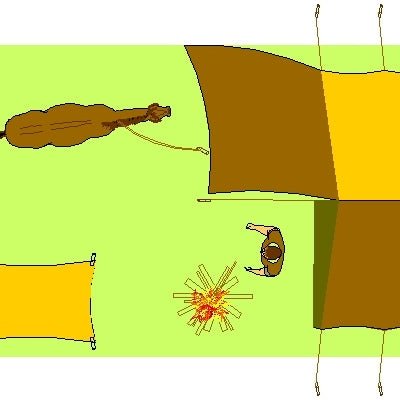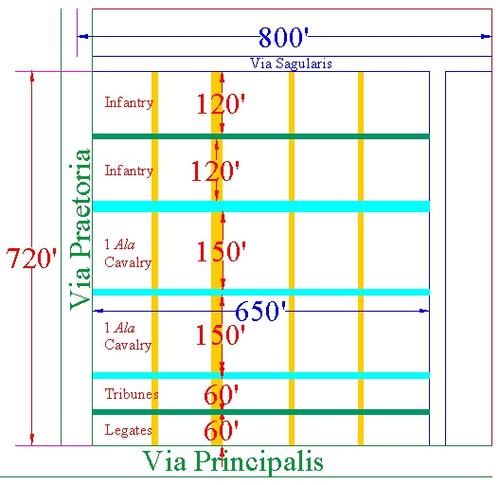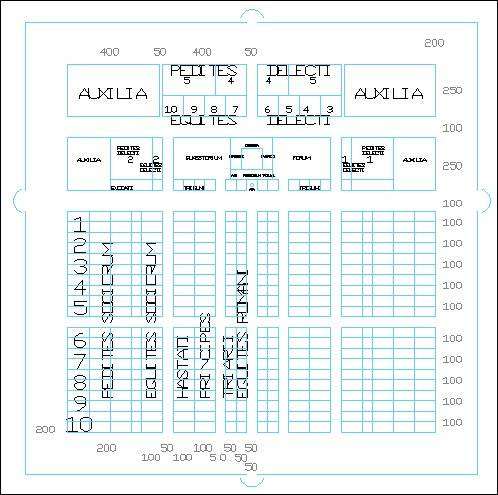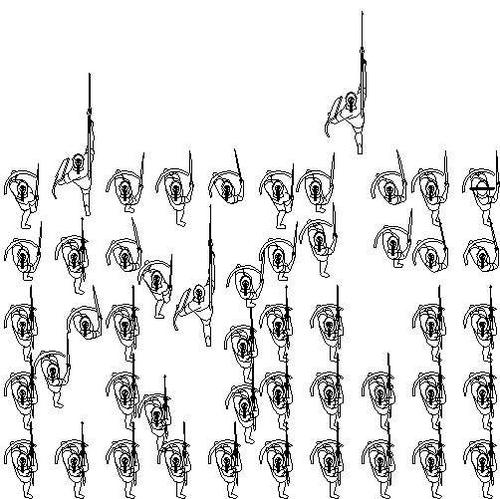Alternatives to gaps: closing and re-opening them
Peter Connolly, in his book Greece and Rome at War, describes how the legion closed the gaps between units by having the rear centuries move into the gaps once the skirmishers had retreated. The second line exchanged places with the first by reversing the process, bringing the second line into the re-opened gaps, withdrawing the first line and then moving the rear centuries of the second line back into the gaps. This section shows this process in 15 frames.
Frame 1starts with the standard cohort formation. At this point the skirmishers would have already withdrawn through the gaps and the legion is ready to begin the process of closing the gaps. Frames 1 through 5 show the process of closing the gaps. This would, presumably, have been done before the legion charged the enemy line.
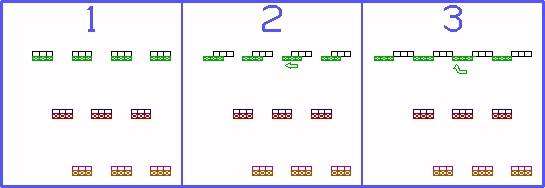 The green unit has to turn, march or jog 98 feet to its left, turn again, then advance 24 feet forward. It would take at least a few seconds [2] for the unit to turn in formation and begin to jog. At a moderate jogging rate of 6 to 8 feet per second it would take about 15 seconds to cover the 98 feet and stop [15] and another five to ten seconds to regroup and tighten up the formation [10]so that it would fit in the gap. The march forward would be at a relatively slow pace and would take five or ten seconds [10].
The green unit has to turn, march or jog 98 feet to its left, turn again, then advance 24 feet forward. It would take at least a few seconds [2] for the unit to turn in formation and begin to jog. At a moderate jogging rate of 6 to 8 feet per second it would take about 15 seconds to cover the 98 feet and stop [15] and another five to ten seconds to regroup and tighten up the formation [10]so that it would fit in the gap. The march forward would be at a relatively slow pace and would take five or ten seconds [10].
Adding up the numbers in the brackets, the whole maneuver, under ideal conditions, could possibly be accomplished in 37 seconds. Under battle conditions it would surely take longer.
Frame5 shows the centuries of the first line deployed in battle formation. Presumably the legion would fight in this formation until the first line was exhausted. At that point the rear centuries would disengage, maneuver to behind the first centuries and the second line would advance through the gaps.
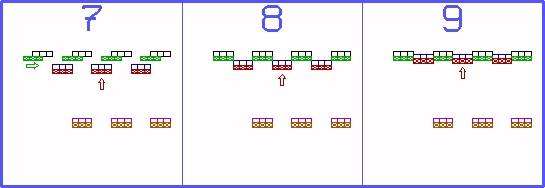 The maneuvers necessary to replace the first line with the second are shown in frames 6 through 15. In frames 6 though 7 the centuries of the first line re-open the gaps, in frames 8- 10 the cohorts of the second line move up through the gaps. In frames 11 and 12 the cohorts of the first line retreat, re-opening gaps in the line of battle. In frames 13 and 14 the rear centuries of the second line re-close the gaps and in Frame 15 the legion is once again in battle formation
The maneuvers necessary to replace the first line with the second are shown in frames 6 through 15. In frames 6 though 7 the centuries of the first line re-open the gaps, in frames 8- 10 the cohorts of the second line move up through the gaps. In frames 11 and 12 the cohorts of the first line retreat, re-opening gaps in the line of battle. In frames 13 and 14 the rear centuries of the second line re-close the gaps and in Frame 15 the legion is once again in battle formation
The time it would take to accomplish this maneuver would be much greater than the half minute or so described above.
In the first phase the green units have to march 24 feet in formation backwards away from the enemy. They have to do this together and in coordination with the other green units along the extended battle line.
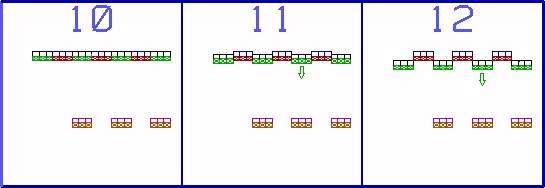 The march backwards would have to be done with great care to keep the unit in line and avoid tripping. It is hard to imagine that it could be done faster than about one step per second. At that rate it would take 12 seconds for the green unit to retreat. But this unit is being replaced after some time in combat. Its men would be exhausted, many could be wounded. The ideal 12 second rearward march, and all of their other manuevers, would more likely take twice as long [12 * 2 = 24].They then turn and jog to their right stop and turn again [( 2 + 15 + 2) *2 = 38], Frame 8. The red units can then march 48’ forward to fill the gaps [ 20]. At Frame 10 the combined green units begin another backward march of 48 feet to clear the gaps [24 * 2 = 48]. Once the green units are clear, Frame 13, the red units have to repeat the original manuever [37]. The total time under ideal conditions would be something in the order of 167 seconds, almost three minutes. For this entire time the legion’s ability to fight would be seriously impaired.
The march backwards would have to be done with great care to keep the unit in line and avoid tripping. It is hard to imagine that it could be done faster than about one step per second. At that rate it would take 12 seconds for the green unit to retreat. But this unit is being replaced after some time in combat. Its men would be exhausted, many could be wounded. The ideal 12 second rearward march, and all of their other manuevers, would more likely take twice as long [12 * 2 = 24].They then turn and jog to their right stop and turn again [( 2 + 15 + 2) *2 = 38], Frame 8. The red units can then march 48’ forward to fill the gaps [ 20]. At Frame 10 the combined green units begin another backward march of 48 feet to clear the gaps [24 * 2 = 48]. Once the green units are clear, Frame 13, the red units have to repeat the original manuever [37]. The total time under ideal conditions would be something in the order of 167 seconds, almost three minutes. For this entire time the legion’s ability to fight would be seriously impaired.
Conclusion
The idea of exchanging the units in this fashion is elegant but does present some difficulties.
The first difficulty is disengaging the enemy so that the gaps can be re-opened. Presumably, on some signal, the front line troops would stop fighting and begin to take a few steps back, thus disengaging. But the individual enemy soldiers engaged in close hand-to-hand combat would surely tend to regard this as a retreat and would press forward. Now, the purpose of the maneuver is to relieve soldiers of the first line who have been unsuccessful, who are exhausted, and many of whom may be wounded. These men would be poorly equipped to withstand a vigorous assault by enemy troops who now believe they have the upper hand as the Romans retreat. Far from placidly allowing the Romans to disengage, the enemy would be far more likely to hotly pursue and press the retreating Roman formations. And if the enemy fills the gaps as the Romans vacate them then the whole point of the maneuver is lost for there are no openings left for the fresh units to fill.
Another problem is the difficulty of marching backwards in formation. Opening the gaps requires alternate centuries to disengage the enemy and retreat backward for at least 24 feet, Frame 6. Later, Frame 12, the whole cohort has to retreat backward for 98 feet. Since it would have been suicidal for the soldiers to turn their backs on the enemy, the units would have to retreat by marching backwards, protecting themselves from the enemy and maintaining their position in rank and file. The conditions under which the withdrawal had to occur are formidable. The withdrawing unit is tired, many are wounded, the terrain is unfamiliar and uneven, formations have shifted, the sounds of battle make signaling difficult. It is hard to imagine how they could have done it successfully and as a normal part of their battle maneuvers.
Filling the gaps by shuffling sideways
Kieppe solves the problem of gaps by postulating a closed and an open order. The maniple would have arranged itself in closed order for muster but have opened the intervals between the files to about two meters (six feet) for battle. In his plan the second rank (not shown) would place itself in the intervals between the men of the first to close the small gaps.
 This solution also has several difficulties..
This solution also has several difficulties..
Each file would be expected to move sideways a different number of steps so that the entire formation would have equal six foot spacing. If the first file stayed in place the next file would move only 0.9m (3’) but the last file would have to move over 9m (27’) and each file in-between would have a different distance to move. This would be a complicated maneuver to accomplish on the field of battle.
It is possible to imagine the army performing such a maneuver before the battle began. But, for this to have been a mechanism to exchange units it would have had to occur during battle as well. To re-open the gaps once combat has begun would be impossible. The front line soldier would be expected to move laterally along a hostile enemy front to precisely reform the original formation so that elements from the second line could advance into the spaces. As Peter Connolly argues (Page 140) even if the rear ranks could accomplish this task, the front ranks, under direct attack by the enemy, could not.



